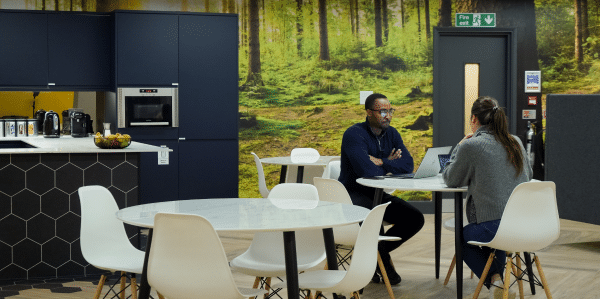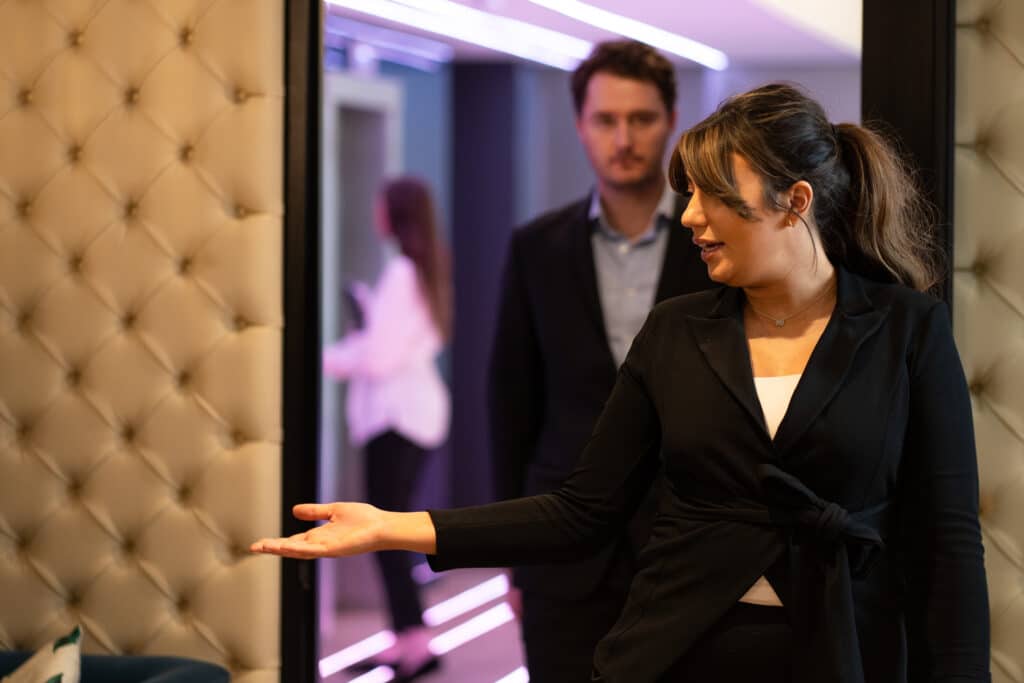Office ergonomics refers to designing and arranging office space to suit staff needs with a focus on maximising comfort, efficiency and productivity while reducing the risk of work-related injuries.
A major component of office ergonomics is office furniture such as chairs, desks and other accessories. These should all be designed to encourage optimum posture and healthy movement.
Making sure that your office is designed with ergonomics in mind is vital for several reasons, namely:
- Health – ergonomically designed offices can improve staff health by reducing work-related injuries caused by strain and poor posture.
- Greater productivity: when workers are comfortable and pain-free, they can better focus on their tasks which will inevitably lead to increased productivity. Good ergonomics can also reduce fatigue allowing staff to achieve more during the working day. According to a study by the American Journal of Public Health, businesses that invest in ergonomic office furniture experience a 67% reduction in sick days.
- Improved mental health – investing in ergonomic office furniture sends a message to employees that tells them you care. Workers who feel valued are more likely to feel satisfied with their jobs. They’re also more likely to stay for longer, reducing your recruitment costs. The International Journal of Human-Computer Interaction found that ergonomic workspaces can increase employee satisfaction by as much as 24%,
Workplace risks
According to government statistics, 1.7 million UK workers suffered from work-related ill health between 2023 and 2024 and 32% of those were musculoskeletal disorders which are a risk factor if office furniture is not designed with ergonomics in mind.
Musculoskeletal health refers to muscles, bones, cartilage, tendons, ligaments and connective tissues. Musculoskeletal conditions can affect people of all ages, can limit mobility and lead to early retirement.
The most likely areas affected by musculoskeletal disorders are the lower back, arms, wrists, hands, neck, hips, legs, knees, feet and ankles.
Ergonomic office furniture
Encouragingly, ergonomic office furniture is becoming increasingly popular in the UK with the market expecting to reach around £3 billion this year. We are the second-largest furniture maker in Europe.
Ergonomic office furniture offers maximum support to the body’s natural posture while reducing strain and discomfort. The following should be ergonomically designed to mitigate the risk of strain and/or injury.
- Office chairs – an ergonomic office chair should have adjustable features, such as an adjustable backrest and seat height along with the ability to position armrests and lumbar support to prevent back pain. The chair should support and encourage good posture throughout the working day.
- Desks – flexible desks can help improve comfort and productivity. Adjustable desks, for example, allow employees to sit or stand, encouraging them to move and reducing the risks associated with sitting for long periods.
- Screen arms – arms enable staff to adjust the position of their computer monitors. The computer should be at eye level to reduce the risk of eye and/or neck strain. Screen arms allow users to adjust the monitor to suit their individual needs without difficulty.
- Keyboard and mouse accessories – an ergonomic keyboard looks a little different to the standard variety. Designed to encourage natural hand and wrist positions, they reduce the risk of repetitive strain injury. Also, mouse pads with wrist support lessen pressure on the wrist.
- Laptop stands – stands allow laptop users to adjust the height of their screens to eye level, promoting better posture and alleviating neck strain. Laptops can also be combined with external ergonomic keyboards and mice to create a better set-up.
- Document stands – a document stand allows staff to position documents at eye level, reducing repetitive neck movements and avoiding strain.
- Cable management solutions – organising cables results in a tidier workspace and removes trip hazards.
Creating an ergonomic office space
Consider the following when creating an ergonomic work environment.
- Evaluate workstations – assess each workstation and look for any ergonomic risks, such as broken office chairs, or computer monitors that can’t be adjusted, lack of document holders, etc.
- Choose ergonomic furniture – invest in furniture designed to promote health and well-being. At the very least, desks, chairs and accessories should be ergonomic.
- Educate staff – offer training on the advantages of ergonomics and teach employees how to adjust workstations, desks and chairs in ways that will improve their posture and reduce the risk of strain.
- Encourage movement – foster an office culture that encourages staff to take screen breaks to stretch and move. This can help reduce risks associated with sitting in the same position for long periods.
- Review regularly – continue to review the effectiveness of your ergonomic provision and make any necessary adjustments. Ask for feedback so that you can spot any areas that need improvement.
Conclusion
Investing in office ergonomics and ergonomic office furniture is a wise business move as it will improve employee health and well-being, enhance productivity and help to create a positive office culture. Ensuring that all workspaces support natural movements and postures, reduces the risks of work-related injuries and creates a culture of well-being. A proactive approach benefits your staff and contributes to the overall success of your organisation.

Charlotte is one of One Avenue’s longest standing Business Manager and is
heading up our flagship wellness centre, Charlotte is an expert on the local
area of Farringdon, allowing her to tell you some of her best
recommendations.
You may also like...
Contact Us
Speak to one of our team today who would
be delighted to provide you with information,
discuss your requirements or book in a
viewing to see the office space for yourself.


